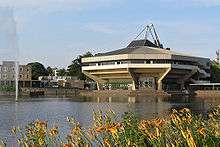Plate glass university

The term plate glass university (or plateglass university or plate-glass university) refers to a group of universities established or expanded in the United Kingdom during the mid-twentieth century. In 1963, the Robbins Report on higher education recommended a major expansion of the British university system, which was realised through the establishment of nine completely new universities and the conversion of the ten existing Colleges of Advanced Technology into full universities. Keele University was established in 1949 but has a similar history and is usually considered part of this group as well. While the Robbins Report was responsible for the broader policy that governed the early development of these institutions Lord Robbins was not responsible for most of the individual institutions as many applications for reclassification had already been accepted by the University Grants Committee in the later 1950s/early 1960s.
Origin of terminology
The term "plateglass" was coined by Michael Beloff for a book he wrote about these universities,[1] to reflect their modern architectural design which often contains wide expanses of plate glass in steel or concrete frames. This contrasted with the (largely Victorian) red brick universities and the older ancient universities.
- "I had at the start to decide upon a generic term for the new universities – they will not be new for ever. None of the various caps so far tried have fitted. "Greenfields" describes only a transient phase. "Whitebrick", "Whitestone", and "Pinktile" hardly conjure up the grey or biscuit concrete massiveness of most of their buildings, and certainly not the black towers of Essex. "Newbridge" is fine as far as the novelty goes, but where on earth are the bridges? Sir Edward Boyle more felicitously suggested "Shakespeare". But I have chosen to call them the Plateglass Universities. It is architecturally evocative; but more important, it is metaphorically accurate."[2]
Beloff's plateglass universities
- Aston University (1966)
- University of East Anglia (1963)
- University of Essex (1964/5)
- University of Kent (1965)
- Lancaster University (1964)
- University of Sussex (1961)
- University of Warwick (1965)
- University of York (1963)
Certain aspects of the design of these universities acknowledges the formation of the group; for example, at Sussex the first batches of student residences to be built were named after some of the other new universities, i.e. "Essex House", "Kent House", "Lancaster House", "Norwich House" (for UEA), and "York House".
Other universities sometimes referred to as plateglass universities
- Dates refer to the granting of university status by Royal Charter, not to founding of the institution.
- University of Bath (1966)
- University of Bradford (1966)
- Brunel University (1966)
- City University London (1966)
- Cranfield University (1969)
- Heriot-Watt University (1966)
- Keele University (1962)
- Loughborough University (1966)
- University of Salford (1967)
- University of Stirling (1967)
- University of Strathclyde (1964)
- University of Surrey (1966)
- Ulster University (1968)
See also
References
- ↑ "The Plateglass Universities". Secker & Warburg. 31 December 1968. Retrieved 3 December 2010.
- ↑ "The Plateglass Universities". Secker & Warburg. 31 December 1968. Retrieved 3 December 2010.
External links
- Toynbee, Polly (2002-06-05) After the jubilation must come the reckoning, The Guardian
- Anti-ageism Laws Will Be Good for All, The Guardian (2003)
- Collini, Stefan (2003-11-06) HiEdBiz, London Review of Books, Vol. 25 No. 21, pp 3–9
- Sheffield University Library Collection